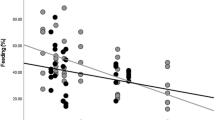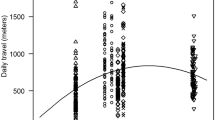Summary
Activity patterns were documented over a 20-month period in six groups of vervet monkeys (Cercopithecus aethiops) in Amboseli National Park, Kenya. Group size varied both among groups and within groups through time. The home ranges of two groups were located in Acacia xanthophloea habitat whereas those of four adjacent groups were located in A. tortilis habitat. Repeated measures analysis of variance, three-way analysis of variance, and meta-analysis of group size effects were carried out on feeding, moving, resting, scanning, allo-grooming, and ‘other’ behavior. Time spent feeding varied seasonally, peaking during periods when A. tortilis seeds were eaten. However, time spent feeding did not vary within or among groups, or between habitats, males and females, or dominants and subordinates. Males spend more time scanning and less time allo-grooming than females, and high-ranking individuals of both sexes spent more time scanning than low-ranking individuals. Among females, subordinates spent more time moving, whereas among males, dominants spent more time moving. Groups living in A. xanthophloea habitat spent more time moving and allo-grooming than groups in A. tortilis habitat but this may have been confounded by the fact that these two groups were on average larger than the others. Significant differences in activity budgets among groups demonstrate that activity patterns observed in one group are not always readily generalized to other groups even when they come from the same population. Group size analyses examined potential costs and benefits of group living. Increased intragroup competition, measured by time spent moving and feeding, was only weakly evident in larger groups. Individuals in larger groups allo-groomed more than individuals in smaller groups. Self-grooming also increased in larger groups. Individuals in larger groups spent less time scanning than individuals in smaller groups, but there was more scanning per group in larger groups than in smaller groups.
Similar content being viewed by others
References
Alexander RD (1974) The evolution of social behavior. Annu Rev Ecol Syst 5:325–383
Altmann J (1974) Observational study of behavior: sampling methods. Behaviour 49:227–265
Barnard CJ (1980) Flock feeding and time budgets in the house sparrow (Passer domesticus L.). Anim Behav 28:295–309
Bertram BCR (1980) Vigilance and group size in ostriches. Anim Behav 28:278–286
Baldellou M, Henzi SP (1992) Vigilance, predator detection and the presence of supernumerary males in vervet monkey troops. Anim Behav 43:451–461
Caine NG, Marra SI (1988) Vigilance and social organization in two species of primates. Anim Behav 36:897–904
Cheney DL (1983) Extra-familial alliances among free-ranging vervet monkeys. In Hinde RA (ed) Primate social relationships: an integrated approach. Blackwell Scientific Publications, Oxford, pp 278–286
Cheney DL (1992) Intragroup cohesion and intergroup hostility: the relation between grooming distributions and intergroup hostility: the relation between grooming distributions and intergroup competition among female primates. Behav Ecol 4:334–345
Cheney DL, Seyfarth RM (1981) Selective forces affecting the predator alarm cells of vervet monkeys. Behaviour 76:25–61
Cheney DL, Seyfarth RM (1985) Vervet monkey alarm calls: manipulation through shared information? Behaviour 94:150–166
Cheney DL, Seyfarth RM (1987) The influence of intergroup competition on the survival and reproduction of female vervet monkeys. Behav Ecol Sociobiol 21:375–386
Cheney DL, Seyfarth RM, Andelman SJ, Lee PC (1988) Reproductive success in vervet monkeys. In: Clutton-Brock TH (ed) Reproductive success. University of Chicago Press, Chicago, pp 384–402
Clutton-Brock TH, Harvey P (1977) Primate ecology and social organization. J Zool London 183:1–39
Dunbar RIM (1991) Functional significance of social grooming in primates. Folia Primatol 57:121–131
Harcourt AH, Stewart KJ (1984) Gorillas' time feeding: aspects of methodology, body size, competition and diet. Afr J Ecol 22:207–215
Harrison MJS (1983) age and sex differences in the diet and feeding strategies of the green monkey (Cercopithecus sabaeus). Anim Behav 31:969–977
Hoogland JL (1979) The effect of colony size on individual alertness of prairie dogs (Sciuridae: Cynomys spp.). Anim Behav 27:394–407
Isbell LA (1990) Sudden short-term increase in mortality of vervet monkeys (Cercopithecus aethiops) due to leopard predation in Amboseli National Park, Kenya. Am J Primatol 40:41–52
Isbell LA (1991) Contest and scramble competition: patterns of female aggression and ranging behavior among primates. Behav Ecol 2:143–155
Isbell LA, Cheney DL, Seyfarth RM (1990) Costs and benefits of home range shifts among vervet monkeys (Cercopithecus aethiops) in Amboseli National Park, Kenya. Behav Ecol Sociobiol 27:351–358
Isbell LA, Cheney DL, Seyfarth RM (1991) Group fusions and minimum group sizes in vervet monkeys (Cercopithecus aethiops). Am J Primatol 25:57–65
Janson CH (1988) Food competition in brown capuchins (Cebus apella): quantitative effects of group size and tree productivity. Behaviour 105:53–76
Kavanagh M (1978) The diet and feeding behavior of Cercopithecus aethiops tantalus. Folia Primatol 30:30–63
Kavanagh M (1981) Variable territoriality among tantalus monkeys in Cameroon. Folia Primatol 36:76–98
Keverne EB, Martensz ND, Tuite B (1989) Beta-endorphin concentrations in cerebrospinal fluid of monkeys are influenced by grooming relationships. Psychoneuroendocrinology 14:155–161
Lee PC (1983) Ecological influences on relationships and social structure. In: Hinde RA (ed) Primate social relationships. Blackwell Scientific Publications, Oxford, pp 225–229
Marsh C (1981) Time budget of Tana River red colobus. Folia Primatol 35:30–50
Milton K (1980) The foraging strategy of howler monkeys: a study in primate economics. Columbia University Press, New York
Post D (1981) Activity patterns of yellow baboons (Papio cynocephalus) in the Amboseli National Park, Kenya. Anim Behav 29:357–374
Powell GVN (1974) Experimental analysis of the social value of flocking by starlings (Sturnus vulgaris) in relation to predation and foraging. Anim Behav 22:501–505
Pulliam R (1973) On the advantages of flocking. J Theor Biol 38:419–422
Richard A (1977) The feeding behaviour of Propithecus verreauxi. In Clutton-Brock TH (ed) Primate ecology: studies of feeding and ranging behavior in lemurs, monkeys, and apes. Academic Press, New York, pp 72–96
Robinson J (1988) Group size in wedge-capped capuchin monkeys Cebus olivaceus and the reproductive success of males and females. Behav Ecol Sociobiol 23:187–197
Ruiter J de (1986) The influence of group size on predator scanning and foraging behaviour of wedge-capped capuchin monkeys (Cebus olivaceus). Behaviour 98:240–258
Schaik CP van (1983) Why are diurnal primates living in groups? Behaviour 87:120–143
Schaik CP van (1989) The ecology of social relationships amongst female primates. In: Standen V, Foley RA (eds) Comparative socioecology: the behavioural ecology of humans and other mammals. Blackwell Scientific Publications, Oxford, pp 195–218
Schaik CP van, Noordwijk MA van, DeBoer RJ, Den Tonkelaar I (1983) The effect of group size on time budgets and social behaviour in wild long-tailed macaques. Behav Ecol Sociobiol 13:173–181
Seyfarth RM (1980) The distribution of grooming and related behaviours among adult female vervet monkeys. Anim Behav 28:798–813
Seyfarth RM, Cheney DL, Marler P (1980) Vervet monkey alarm calls: semantic communication in a free-ranging primate. Anim Behav 28:1070–1094
Sokal RR, Rohlf FJ (1981) Biometry. WH Freeman, New York
Stanford CB (1991) The capped langur in Bangladesh: behavioral ecology and reproductive tactics (Contr Primatol vol 26). Karger, New York
Struhsaker TT (1967) Ecology of vervet monkeys in the Masai-Amboseli Game Reserve, Kenya. Ecology 48:891–904
Struhsaker TT (1973) A recensus of vervet monkeys in the Masai-Amboseli Game Reserve, Kenya. Ecology 54:930–932
Struhsaker TT (1975) The red colobus monkey. University of Chicago Press, Chicago
Struhsaker TT (1976) A further decline in numbers of Amboseli vervet monkeys. Biotropica 8:211–214
Sussman RW (1977) Feeding behaviour of Lemur catta and Lemur fulvus. In: Clutton-Brock TH (ed) Primate ecology: studies of feeding and ranging behavior in lemurs, monkeys, and apes. Academic Press, New York, pp 1–36
Terborgh J (1983) Five new world primates: a study in comparative ecology. Princeton University Press, Princeton, New Jersey
Vehrencamp SL (1983) A model for the evolution of despotic vs. egalitarian societies. Anim Behav 31:667–682
Walters JR, Seyfarth RM (1987) Conflict and cooperation. In: Smuts BB, Cheney DL, Seyfarth RM, Wrangham RW, Struhsaker TT (eds) Primate societies. University of Chicago Press, Chicago, pp 306–317
Waser PM (1977) Feeding, ranging and group size in the mangabey (Cercocebus albigena). In: Clutton-Brock (ed) Primate ecology: studies of feeding and ranging behaviour in lemurs, monkeys, and apes. Academic Press, New York, pp 182–222
Watts D (1988) Environmental influences on mountain gorilla time budgets. Am J Primatol 15:195–211
Western D (1983) A wildlife guide and a natural history of Amboseli. General Printers, Nairobi
Western D, Praet C van (1973) Cyclical changes in the habitat and climate of an East African ecosystem. Nature 241:104–106
Whitten P (1983) Diet and dominance among female vervet monkeys (Cercopithecus aethiops). Am J Primatol 5:139–159
Wolf FM (1986) Meta-analysis (Quantitative applications in the social sciences no. 59). Sage Publications, Beverly Hills, California
Wolfheim J (1983) Primates of the world: distribution, abundance, and conservation. University of Washington Press, Seattle, Washington
Wrangham RW (1980) An ecological model of female-bonded primate groups. Behaviour 75:262–300
Wrangham RW (1981) Drinking competition in vervet monkeys. Anim Behav 29:904–910
Young TP, Lindsay WK (1988) Role of even-age population structure in the disappearance of Acacia xanthophloea woodlands. Afr J Ecol 26:69–72
Author information
Authors and Affiliations
Additional information
Correspondence to: L.A. Isbell
Rights and permissions
About this article
Cite this article
Isbell, L.A., Young, T.P. Social and ecological influences on activity budgets of vervet monkeys, and their implications for group living. Behav Ecol Sociobiol 32, 377–385 (1993). https://doi.org/10.1007/BF00168821
Received:
Accepted:
Published:
Issue Date:
DOI: https://doi.org/10.1007/BF00168821




